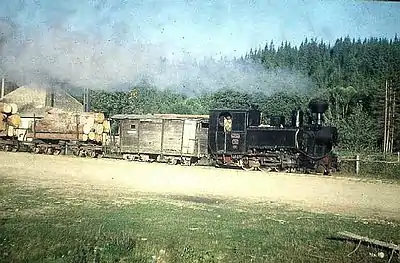Forest railway
A forest railway, forest tram, timber line, logging railway or logging railroad is a mode of railway transport which is used for forestry tasks, primarily the transportation of felled logs to sawmills or railway stations.
In most cases this form of transport utilised narrow gauges, and were temporary in nature, and in rough and sometimes difficult to access terrain.
History
Before the railway was invented, logs were transported in large numbers from the forest down rivers either freely or on wooden rafts. This was not without its problems and wood was often damaged in transit, lost in floods or stranded in shallow water. Suitable rivers were often unavailable in mountainous terrain.
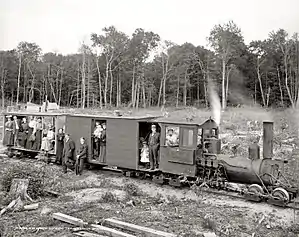
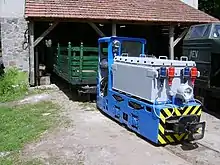
Simple wagonways, using horses and wooden rails, were used from the 18th century. However the invention of the steam locomotive and steel rails soon led to these being employed for forestry. However the difficult terrain within forests meant that narrow-gauge railways, which took up less space, were lighter and easier to build and enabled tight curves to be laid, were preferred. These were the so-called forest railways. In particularly large areas of forest or forests of unusually large trees, such as in the northwestern USA, extensive forest railways were even built using standard gauge exclusively for forestry tasks. Special geared locomotives such as the Shay and Climax locomotive were developed for high tractive effort on rough track. Some forest railways became common carriers when cleared forest land was converted to agricultural or recreational use.
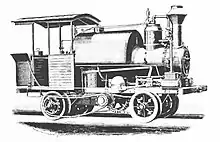
In cases where the railway itself was considered very short-term, or the region was extremely difficult to access, logs would often be laid into the ground as a pole road, rather than the cost and logistics of laying steel rails and sleepers. Pole roads could be extensive; several examples in the southeastern United States extended up to 20 miles (32 km) at the end of the nineteenth century, and used purpose-built steam locomotives.[1]
In addition to steam traction, diesel and petrol-driven locomotives were also used later on. These largely brought animal-hauled transportation to an end on the forest railways. Also common were routes that just used gravity. Wagons loaded with wood would simply roll downhill in a controlled fashion under the pull of gravity. Foresters also travelled on these, at some risk to their lives on occasions – as brakemen. Empty wagons were hauled uphill again by horses.
From the second half of the 20th century forest railways were threatened by road transportation and by the end of the 1960s they had practically disappeared from western Europe. Roads were often laid in their place on the old trackbeds.
In a few Eastern European countries forest railways survived longer, particularly in Russia where there are still some today. In Hungary too there are several forest railways in active service today, some are also used for tourist traffic. The numerous forest railway operations in Romania were closed, with a few exceptions, by the 1990s. In Western Europe there are very few which are even preserved as museum railways.
In Asia and Oceania (Australia and New Zealand) the history and fate of logging tramways/forest railways is similar to Europe, with most lines either converted to motorised truck transport or closing down in the 1960s. Significant numbers of locomotives and other remnants of the former lines are found in museums and museum railways in Australia.
Forest railways in Europe
Germany (selection)
| Railway name | Route | Rail gauge mm | Length km | Traction (GS=Direct Current) | From | To | Operated by | Remarks | |
|---|---|---|---|---|---|---|---|---|---|
| Bavaria | |||||||||
| Reichswald Forest Railway | Sebalder Reichswald | dismantled | |||||||
| Ebersberg Forest Railway | Ebersberg | dismantled | |||||||
| Ruhpolding–Reit im Winkl State Forest Railway | Ruhpolding-Reit im Winkl | 1000 | 23 | 1922 | 1936/37 | dismantled | |||
| Spiegelau Forest Railway | Spiegelau-Finsterau | 600 | 100+ | 1909 | 1960 | dismantled | |||
| Zwieselau Forest Railway | Zwieselau-Buchenau | 600 | 14,5 | 1930 | 1958 | dismantled | |||
| Bächentalbahn | Fall | 750 | ~ 10 | crosses border (see Tyrol) | |||||
| Brandenburg | |||||||||
| Schorfheide Forest Railway | Schorfheide, Döllnkrug-Höpen | 600 | |||||||
| Rhineland-Palatinate | |||||||||
| Wasgau Forest Railway | Bundenthal-Rumbach | 600 | 14,5 | 1921 | 1930 | dismantled | |||
| Saxony | |||||||||
| Muskau Forest Railway | Weisswasser-Bad Muskau | 600 | 50+ | 1895 | Museum Railway | ||||
Austria
| Railway name | Route | Rail gauge mm | T r a c k s | Length km | Traction (GS=Direct Current) | From | To | Operated by | Remarks |
|---|---|---|---|---|---|---|---|---|---|
| Burgenland | |||||||||
| Dörfl Forest Railway (WbD) | Dörfl | 600 | 1 | 9,4 | 1924 | 1933 | WbD | ||
| Großmürbisch Forest Railway (WbG) | (Alsörönök-) border Großmürbisch - Reinersdorfer Bach | 760 | 1 | ~7,5 | 1935 | 1937 | WbG | 4 km in Hungary, dismantled | |
| Großpetersdorf-Rumpersdorf Forest Railway (WGR) | Großpetersdorf - Rumpersdorf | 760 | 1 | ~13,5 | 1920 | ~1933 | WGR | ||
| Güssing - Rohr im Burgenland Forest Railway (WGR) | Güssing - Rohr im Burgenland | 760 | 1 | ~27,0 | 1913 | 1921 | WGR | ||
| Güssing - Neuberg im Burgenland Forest Railway (WGN) | Güssing - Neuberg im Burgenland | 760 | 1 | ~14,0 | 1913 | 1921 | WGN | ||
| Lockenhaus Forest Railway (WbL) | Lockenhaus | 600 | 1 | 14,9 | 1926 | 1956 | WbL | ||
| Punitz Forest Railway (WbP) | Punitz - Punitzer Gemeindewald | 600 | 1 | ~9,0 | Horses | 1905 | ~1933 | WbP | |
| Lower Austria | |||||||||
| Haselbach Forest Railway | Nähe Fahrafeld: Forsthaus - Hochwiese | 600 | 1 | ~2,5 | Gravity, oxen, petrol-driven locos | 1915 | 1918 | BMF | dismantled |
| Forest Railway im Klauswald (WbK) | Klauswald, near Puchenstuben | 600 ? | 1 | 4,5 | 1930 | 1937 | WbK | ||
| Langau - Lackenhofer Höfe Forest Railway (WbLL) | Langau-Lackenhof | 1000 | 1 | ~ 6,7 | Horses | ~1845 | 1867 | WbLL | |
| Lunz-Langau-Saurüsselboden Forest Railway (WbLL) | Lunz am See - Langau - Saurüsselboden | 700 | 1 | 12,2 | Diesel | 1920 | 1974 | WbLL | Forest railway with limited public passenger services, dismantled |
| Lunz-Langau-Saurüsselboden Forest Railway (WbLL) branch | Langau - Lackenhofer Höhe | 700 | 1 | ~6,6 | Diesel | 1920 | 1974 | WbLL | Forest railway with limited public passenger service, dismantled |
| Forest Railway Nasswald | Schwarzau im Gebirge, Nasswald | 600 | 0,6 | Diesel, accumulator | 1985 | Museum railway, new line | |||
| Wastl am Wald - Hühnerkogel Forest Railway (WbW) | Wastl am Wald | 600 | 1 | ~ 3,9 | 1934 | 1945 | WbW | ||
| Forest Railway im Weinsberger Forst (WWF) | Martinsberg-Gutenbrunn - Berglucke | 760 | 1 | ~35,9 | 1920 | 1933 | WWF | ||
| Upper Austria | |||||||||
| Offensee Forest Railway (WbO) | Offensee, Steinkogl - Steibachl | 800 | 1 | 13,9 | 1899 | 1954 | WbO | ||
| Offensee Forest Railway (WbO) | Steibachl - Obere Moosau | 800 | 1 | 1,6 | 1899 | 1954 | WbO | ||
| Reichraming Forest Railway (WbRr) | Schallau-Maieralm-Hansigraben | 760 | 1 | 16,5 | 1920 | 1971 | WbRr | ||
| Reichraming Forest Railway (WbRr) | Maieralm-Unterweißwasser | 760 | 1 | 13,0 | 1920 | 1971 | WbRr | ||
| Reichraming Forest Railway (WbRr) | Reichraming -Hintergebirge | 760 | 1 | 32,7 | Diesel | 1920 | 1971 | WbRr | Forest railway with limited public passenger services, dismantled |
| Salzburg | |||||||||
| Zinkenbach Forest Railway (WbZ) | Zinkenbach, Lagerplatz Hundsleiten-Königsbachalm | 700 | 1 | 6,7 | Diesel | 1921 | 1967 | WbZ | no passenger traffic, dismantled |
| Styria | |||||||||
| Deutschlandsberg Forest Railway (WbD) | Deutschlandsberg - Freiland bei Deutschlandsberg | 760 | 1 | 9,9 | Steam | WbD | no passenger traffic, dismantled | ||
| Deutschlandsberg Forest Railway (WbD) | Kupper-Bärental | 600 | 1 | 8,5 | Steam | WbD | dismantled, link between Freiland and Kupper with 3.1 km long cable car (dismantled) | ||
| Deutschlandsberg Forest Railway (WbD) | Kupper-Hofbauer | 600 | 1 | 9,4 | Steam | WbD | Forest railway, no passenger traffic, dismantled | ||
| Frauenwald Forest Railway (WbF) | Steinhaus am Semmering- Rettenegg | 600 | 1 | 22,0 | Steam | 1902 | 1958 | WbF | Forest railway with limited public passenger services, dismantled, with two inclined lifts |
| Frohnleiten Forest Railway (WbF) | Frohnleiten-Traninger- Rossstall | 760 | 1 | 12,4 | 1925 | 1951 | WbF | dismantled | |
| Frohnleiten Forest Railway (WbF) branch | Traninger- Dionys | 760 | 1 | 5,6 | 1925 | 1951 | WbF | dismantled | |
| Gundersdorf Forest Railway (WbG) | Gundersdorf, Dampfsäge- Höllein | 760 | 1 | 4,0 | WbG | dismantled | |||
| Ingering Forest Railway (WbI) | Ingering -Seeboden | 720 | 1 | ~10,5 | ~1885 | 1938 | WbI | dismantled | |
| Radmer Forest Railway (WbRa) | Hieflau-Radmer-Neuhaus | 830 | 1 | ~14,0 | 1920 | 1967 | WbRa | ||
| Radmer Forest Railway(WbRa) | Hieflau-Radmer-Neuhaus | 900 | 1 | ~14,0 | 1200 V DC | 1967 | 1979 | ||
| Trieben Forest Railway (WbT) | Trieben - Lager Seyfried | 800 | 1 | ~ 10,8 | 1900 | ~1939 | WbT | ||
| Tyrol | |||||||||
| Klammbach Forest Railway | Achenkirch | 760 | 6,6 | 1914 | 1960 | Klammbachwaldbahn | |||
| Bächental Forest Railway | Bächentalbahn | 750 | 10,2 | 1930 | 1956 | see also Bavaria | |||
France
- Abreschviller Forest Railway, remains of a once extensive forest railway networks in the Vosges, museum railway
- also the Voies Ferrées des Landes a group of short lines built primarily to serve the forestry industry in the Landes forest
- The Forest Railway Welschbruch, built and used while the German Empire ruled Alsace, was used to carry wood logs down to the valley of Barr
Poland
(all lines on the Polish eastern border from north to south)
- Forest Railway from Płociczno - Bryzgiel (from 1923)
- Forest Railway from Czarna Białostocka (from 1919)
- Forest Railway Hajnówka, Museum Railway
- Bieszczady Forest Railway
Slovakia
- Hronec – Čierny Balog Forest Railway (Schwarzgranbahn), museum railway
- Vychylovka Forest Railway, museum railway
- Považská lesná železnica
Sweden
- Ohsabanan, Värnamo, Småland, active forest railway and tourist trains
Hungary

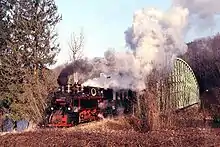
- Almamellék Forest Railway, tourist trains
- Csömödér Forest Railway, active forest railway and tourist trains
- Debrecen Forest Railway, tourist trains
- Felsőtárkány National Forest Railway, tourist trains
- Gemenc State Forest Railway, active forest railway and tourist trains
- Mátravasút, (Gyöngyös) tourist trains
- Kaszó Forest Railway, tourist trains
- Kemence Forest Railway, tourist trains and narrow gauge museum
- Királyrét Forest Railway, tourist trains
- Lillafüred Forest Railway, tourist trains
- Mesztegnyő Forest Railway, (forest railway ceased 1999) tourist trains
- Nagybörzsöny Forest Railway, tourist trains
- Pálháza Forest Railway, tourist trains
- Szilvásvárad Forest Railway, Szilvásvárad, tourist trains
Romania
- Viseu de Sus, Wassertalbahn, active forest railway used for forestry and tourism
- Covasna - Comandău Forest Railway, with cable car, museum operation under construction
Russia
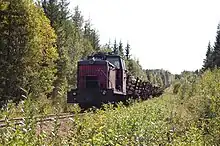
- Alapayevsk narrow-gauge railway, passengers and tourist trains
- Apsheronsk narrow-gauge railway, active forest railway used for forestry
- Belorucheiskaya narrow-gauge railway, active forest railway used for forestry
- Kobrinskaya narrow-gauge railway, active forest railway used for forestry
- Konetsgorskaya narrow-gauge railway, active forest railway used for forestry
- Kudemskaya narrow-gauge railway, passengers and tourist trains
- Loyginskaya narrow-gauge railway, active forest railway used for forestry
- Nyubskaya narrow-gauge railway, active forest railway used for forestry
- Lundanskaya narrow gauge railway, active forest railway used for forestry
- Oparinskaya narrow-gauge railway, active forest railway used for forestry
- Pizhemskaya narrow gauge railway, active forest railway used for forestry
- Sharya Forest Museum Railway, passengers and tourist trains
- Udimskaya narrow-gauge railway, active forest railway used for forestry
- Zelennikovskaya narrow-gauge railway, active forest railway used for forestry
Logging railroads in North America
A logging railroad describes railroads, pole roads, tram roads, or similar infrastructure used to transport harvested timber from a logging site to a sawmill. Logging railroads vary in gauge and length, with most forested regions of the world supporting a railroad of this type at some point.
While most railroads of this variety were temporary, it was not uncommon for permanent railroads to take their place as a complement to logging operations or as an independent operation once logging ended.
British Columbia
Ontario
- Emery Lumber Company railway, Greater Sudbury[2]
- Stone Lumber Company railway, St. Joseph Island[3]
Saskatchewan
California
- Almanor Railroad
- Arcata and Mad River Railroad
- Bear Harbor and Eel River Railroad
- Boca and Loyalton Railroad
- Bucksport and Elk River Railroad
- California Western Railroad
- Camino, Placerville and Lake Tahoe Railroad
- Caspar, South Fork and Eastern Railroad
- Diamond and Caldor Railway
- Diamond Match Company
- Feather River Railway
- Fort Bragg and Southeastern Railroad
- Goodyear Redwood Company
- Lake Valley Railroad
- Madera Sugar Pine Company
- McCloud Railway
- Mendocino Lumber Company
- Metropolitan Redwood Lumber Company
- Michigan-California Lumber Company
- North Pacific Coast Railroad
- Oregon and Eureka Railroad
- Pacific Lumber Company
- Rockport Redwood Company
- Santa Cruz Lumber Company
- Sugar Pine Lumber Company
- Usal Redwood Company
- West Side Lumber Company railway
- Yosemite Lumber Company
New England
New Mexico
Oregon
South Carolina
West Virginia
Washington
- Chehalis Western Railroad
- Mosquito and Coal Creek Railroad
- Siler Logging Railroad
- White River Lumber Co
Forest railways in Asia
Indonesia
Taiwan
Forest railways in Oceania
Australia
- Powelltown Tramway, Victoria
- Tyers Valley Tramway, Victoria
- Timber railway lines of Western Australia
New Zealand
- Ellis and Burnand Tramway, Ongarue
- Brownlee Tramway, in operation from c.1881 through to 1915
Other railways for the transport of goods
- Field railways (see: Feldbahn) for the transportation of rural produce; also originally for military use as well
- Harbour or port railways for loading and unloading goods within a port
- Industrial railways for transporting goods from factories
- Hallig railways for transporting coastal defence materiel.
- Bush tramways in New Zealand, see West coast trams in New Zealand
- Light railway
- Military railways (see also: Heeresfeldbahn) for transporting military supplies and troops
- Mining railways for ore transportation
- Tramway (industrial)
- Wagonway
- Rail transport
Notes
- "Pole Road Locomotives of the Early Days," Trains magazine, February 1948
- "Sudbury Area Mining Railways". Old Time Trains. Retrieved 28 November 2020.
- "Remember This? Did you know there was a railway on St. Joseph Island?". SooToday.com. 15 January 2017. Retrieved 22 November 2020.
- "Category:Springfield Railway - HSWwiki". Retrieved 14 April 2021.
- "Remains of Nova Scotia's New France". Retrieved 14 April 2021.
- Rice, Douglas M. Log and Lumber Railroads of New England (3rd edition) The 470 Railroad Club (1982) p.2
- "Eagle Lake & West Branch Railroad". Richard N. Symonds, Jr. Retrieved 2012-12-20.
- Pike, Robert E. Tall Trees, Tough Men W.W.Norton & Company (1999) ISBN 0393319172 p.164
